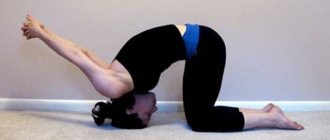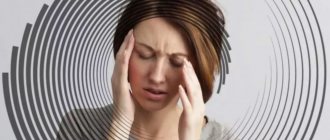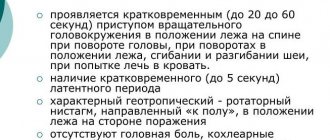Dizziness and vestibular disorders are related. The human vestibular apparatus is located in the inner part of the hearing organ. The human vestibular apparatus has receptors that are very sensitive and immediately detect any changes in body position. Vestibular vertigo creates a sensation of imaginary rotation of objects around the patient. Most often it is caused by certain damage to the vestibular apparatus; dizziness occurs as a result of damage to the central or peripheral parts of the vestibular analyzer. Other types of dizziness are associated with various diseases and are not related to damage to the vestibular system.
At the Yusupov Hospital they diagnose diseases that cause vestibular vertigo. In the hospital you can undergo examination, treatment and recovery in a rehabilitation clinic. The clinic carries out rehabilitation measures, uses therapeutic exercises, and various types of physiotherapeutic procedures. Instructors select exercises on simulators for patients suffering from dizziness. The vestibular apparatus, which is treated using various methods, is restored in 50-80% of patients after treatment and rehabilitation.
How to treat vestibular vertigo
Dizziness is a common complaint among patients about feeling unwell. Women and the elderly most often suffer from dizziness. Depending on the cause of dizziness, the doctor prescribes treatment. Treating dizziness is a difficult task for a doctor. He refers the patient for examination to determine whether dizziness is caused by diseases. The patient is prescribed symptomatic treatment, which helps to remove symptoms - nausea, vomiting, and stop attacks of dizziness. Vestibular suppressors are used to stop attacks. To prevent attacks from developing, your doctor may prescribe anticholinergic drugs. Such drugs are prescribed with caution to elderly people due to side effects - hallucinations, amnesia, they can cause urinary retention and psychosis in an elderly patient. Some types of antihistamines and benzodiazepines are also prescribed to enhance the inhibitory response of GABA to the patient’s vestibular system.
When to expect an effect
As experts and patients themselves say, a positive result after using gymnastics using the Brandt-Daroff method can be expected after completing the first set. You need to perform the maneuver 5 repetitions each morning, afternoon and evening.
Each set should take no more than 10 minutes. If an episode of dizziness has occurred, then it is better to perform the maneuver for 2 weeks. But doctors say that within a day after the gymnastics, the patient’s condition improves significantly.
Vestibular gymnastics, regardless of which of the Brandt-Daroff or Epley maneuvers was used, is a safe and most effective way to independently reduce, and in some cases completely get rid of, the symptoms of dizziness.
If maneuvers do not help, then it is better to seek qualified help. The doctor will help you choose a different set of exercises and, if necessary, prescribe medication.
Vestibular vertigo: symptoms and treatment in older people
Dizziness (vertigo) is manifested by the illusion of rapid rotation of objects around the patient. It may be accompanied by vomiting, nystagmus, nausea, and ringing in the ears. When vestibular vertigo develops in older people, the causes can be varied: lack of blood supply to the brain (cerebral ischemia), multiple sclerosis, head injuries, some types of brain tumors, tumors of the auditory nerve, hormonal imbalance, atherosclerosis, and other disorders. Treatment of vestibular vertigo (vertigo) in older people begins with finding the cause of the dizziness and treating the underlying disease. Vestibular gymnastics for dizziness in older people improves well-being, has a beneficial effect on the heart, musculoskeletal system, and nervous system. Treatment of vestibular vertigo is carried out with the help of drug therapy, physiotherapy, physical therapy, and reflexology.
Contraindications for use
Vestibular gymnastics performed at home is very beneficial for the human body. But before you start doing exercises using the Brandt-Daroff method or using any other method, you should definitely consult a doctor. Such activities have a number of contraindications, and if they are not taken into account, then the patient’s already serious condition can be aggravated.
You cannot use gymnastics if:
- serious disturbances in breathing rhythm are observed;
- the patient’s medical history contains records of heart problems;
- The patient has a cold or infectious disease.
Diseases of the vestibular system and dizziness
There are a number of diseases that lead to disorders of the vestibular apparatus:
- Vertebrobasilar syndrome.
- Meniere's syndrome.
- Vestibular neuronitis.
- Thrombosis of the auditory artery.
- Chronic bilateral vestibulopathy.
Vestibular vertigo can be caused by damage to the vestibular nucleus of the brain stem, the vestibular centers of the brain and vestibular connections may be affected. If the vestibular analyzer is affected, the patient will experience certain symptoms:
- Noise in ears.
- Hearing loss.
- Constant dizziness.
When the central parts of the vestibular apparatus (cerebellum, brain stem) are affected, benign paroxysmal positional vertigo, vestibular neuronitis or Meniere's disease are most often diagnosed.
Benign vestibular vertigo
Benign vestibular vertigo is most often considered a pathology of the inner ear; dizziness often occurs when turning the head to the side. The disease may manifest as sudden severe dizziness, nausea and vomiting. Paroxysmal benign positional vertigo develops as a result of the deposition of calcium salts in the ampulla of the semicircular canal. Peripheral vestibular vertigo occurs when the peripheral part of the vestibular apparatus is damaged. Systemic vestibular vertigo is manifested by symptoms of swaying one's own body, rotating objects, bending or falling, accompanied by impaired hearing, balance, nausea and vomiting. Caused by damage to the central or peripheral part of the vestibular system.
Exercises for vestibular vertigo
Dizziness often occurs when turning the head or body - this forces patients to try to avoid such movements. Gymnastics for patients with vestibular system disorders includes various types of exercises, including exercises with head and body turns. Exercises can be performed while sitting on a bed, with or without a pillow, sitting on a chair, or standing. The exercises are based on the principle of sensory mismatch between the movements of the eyes, torso and head. Special simulators that work on the principle of biofeedback will help increase the effectiveness of gymnastics. During the training period, you should avoid taking sedatives and alcohol.
IP – LYING ON YOUR BACK
- Arms extended behind the head, stretching in four counts. Repeat 6-8 times.
- Arms are extended behind the head, without lifting your hands from the floor, raise your head and look at your outstretched socks. Repeat 4-6 times
- “Bicycle” - put your hands under your head, legs bent, 3 sets for a count of 10.
- Legs bent at the knees, straighten your legs up, spread them apart, then connect them and lower them down. Repeat 6-8 times.
- Diaphragmatic breathing: inhale - inflate the stomach, exhale - draw in the stomach, 6-8 times.
Tablets for vestibular vertigo
Drugs for vestibular vertigo are Betaserc, Betagistin, Tagista, Vestibo, as well as drugs that support the endocrine system, the heart, and reduce blood pressure. Betaserc improves blood circulation in the brain and promotes the functioning of the vestibular apparatus. Betahistine is often used in complex treatment; it helps with nausea and vomiting. Tagista improves blood circulation in the brain and reduces lymph pressure in the labyrinth of the inner ear. A stable effect is achieved after a month of treatment. Vestibo improves blood circulation in the inner ear and brain; the drug is used in complex therapy.
Consolidate the result
Today, in the world of modern technology, dizziness is mainly treated without the use of medications. Oral medications may be prescribed if the patient is experiencing an acute period when the person’s standard of living has reached critical levels and dizziness is also accompanied by nausea and a gag reflex.
Drug treatment helps alleviate the condition and improve the condition of life.
The patient may be prescribed the following medications:
- Dramamine. This is an antihistamine that inhibits the vestibular apparatus of the inner ear, affecting primarily the otoliths. The medicine has an antiemetic, sedative, anorexigenic effect, and eliminates dizziness. Take 1 tablet. up to 3 times a day. The duration is set individually. A package of 10 tablets will cost an average of 300 rubles.
- Cinnarizine. This medicine belongs to the group of vasodilators and effectively helps with migraines and dizziness. For each disease, and the drug can be prescribed for pain relief and treatment of vascular pathologies, the dosage and course are selected individually. The standard dosage for the treatment of dizziness is 1 tablet up to 3 times a day. It should be taken only after meals, as the drug can irritate the gastric mucosa. The average price for 1 unit of goods is 100 rubles.
Cinnarizine tablets - Vestibo. This is a drug from the group of vestibulolytics, prescribed to people suffering from attacks of dizziness. The medicine has similar properties to histamine, improves the flow of blood into the basilar arteries, slowing down the work of some prescriptions and relieving the symptoms of dizziness, and has a positive effect on the brain stem. Packaging the drug will cost an average of 200 rubles.
- Tanakan. This is a drug from the group of herbal nootropics. Helps improve all metabolic processes in the body, improves blood flow, increases blood flow to the brain, normalizes vascular tone, and stops the active development of thrombosis. Take the drug 1 pill three times a day. The average cost of the drug is from 500 rubles.
- Cerucal. This is an antiemetic. Acute dizziness often causes bouts of vomiting, and Cerucal helps eliminate them. The dose and course are selected individually, taking into account contraindications and features of the course of the disease. The average cost of the drug is from 200 rubles.
But doctors use positional maneuvers as the primary treatment for dizziness. Their action is to change the position of the patient’s body and head in space. It is thanks to such exercises that it is possible to move the otoliths, located in the ear canals, to the part of the vestibular apparatus, where they should be. BPPV attacks may occur during such maneuvers.
There are several such maneuvers that you can perform independently without the help of a specialist at home, including the Brandt-Daroff maneuver, and there are also those that must be supervised by a doctor or trainer.
The table below shows several maneuvers that can help relieve dizziness. They are recommended if Brandt-Daroff vestibular gymnastics did not produce the desired results or there are contraindications to its use.
| Maneuver | Execution Features |
| Semonta | This technique is quite effective, but it is better to perform it in the presence of a doctor, because during it an attack of dizziness may occur that will need to be stopped. The maneuver is performed in a sitting position, with your feet on the floor. The patient turns his head 45 degrees to one side, all movements are slow, without jerking. The doctor fixes the head in this position, and the patient takes a position lying on his side and stays there for 2 minutes. Afterwards the patient returns to the original position. They repeat the maneuver, only turning their head and lying down on the other side. |
| Epley | This maneuver is also performed in the presence of a medical professional. The patient should assume a sitting position. Feet are on the floor, head is turned to the side 45 degrees. The medical worker fixes the head, and the patient lies on his back, throwing his head back as far as possible, hold for 1 minute. Next you need to turn your head in the other direction, and then the person turns his whole body on its side. Hold again for 30 seconds, and then return to the starting position. |
| Lempert | This type of gymnastics is very similar to the Epley maneuver. The main difference is that after the body turns on its side, its movement does not stop. The body must continue to rotate around its axis. |
All the maneuvers described above are often used to treat dizziness; there are a number of others, but as practice has shown, it is the 4 described that give the best effect. Treatment usually lasts no more than a week, but most often it goes away faster.
In the most difficult cases, surgery for dizziness can be used:
- labyrinthomia – used for the chronic stage of Meniere’s disease;
- ototoxic antibiotics - effective for Meniere's disease;
- neurovascular decompression – for vestibular paroxysm;
- surgery to remove neuroma;
- perilymphatic fistula surgery.
Treatment in Moscow
The best treatment for vestibular disorders is considered to be exercises for dizziness or vestibular rehabilitation. Vestibular rehabilitation is carried out in many special centers, including the rehabilitation center of the Yusupov Hospital. Therapeutic gymnastics is carried out by an instructor, classes are developed individually for each patient. A preliminary examination by a neurologist will help determine the cause of dizziness, and the doctor will prescribe effective drug treatment. A neurologist will tell you what examination to undergo and how to cure vestibular vertigo during your consultation.
Useful tips for patients
Vestibular gymnastics will be most effective if you follow a number of basic rules:
- The exercises should be performed in a well-lit room, so that there are no objects with sharp corners nearby, and a carpet without any folds that could lead to a fall and injury to the patient.
- The maneuver is performed using soft surfaces, such as a yoga mat, mat, blanket or thick mat.
- You need to choose comfortable clothing so that it does not constrain or limit movement. But it should not be too wide so that the patient does not get confused in it.
- Shoes must be flat-soled.
- While doing gymnastics, there must be a coach or a loved one nearby who can come to the rescue if necessary.
- You should not overload your body; as soon as even a slight feeling of fatigue appears, you need to stop.
- The load should be increased gradually to prepare the body and prevent relapses.
- Regularity is also important.
- If the patient is feeling unwell, it is better to postpone performing gymnastics until the condition improves.
- Gymnastics is not a separate type of treatment; it will only be beneficial in combination with drug treatment.









